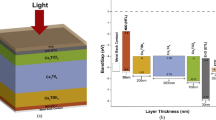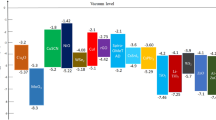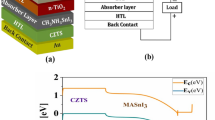Abstract
In this research work, eco-friendly and tin-halide Cs2SnI6-based perovskite coupled with the various all-inorganic charge collective layers like ZnO, TiO2, CdS, GO; CuI, Cu2O, and MoO3, via one-dimensional solar cell capacitance simulator (SCAPS 1D). Among the various proposed electron and hole transport layers (ETLs and HTLs), Cs2SnI6, GO, and Cu2O are the most adequate materials for the efficient and stable perovskite solar cells (PSCs). In the present study, we have proposed a novel architecture FTO/GO/Cs2SnI6/Cu2O/Au with outstanding device performances. Also, we have analyzed and validated the impact of various factors like thickness of absorber, ETL, and HTL layer; defect density, and working temperature on the performances of the solar cells. The novel configuration possessed excellent photovoltaic outputs with a power conversion efficiency of 25.12%. The other obtained performances for the proposed novel configuration were 27.15 mA/cm2, 1.3 V, and 68.78% for the short-circuit current (Jsc), open-circuit voltage (Voc), and fill factor (FF). The effect of series resistance is also reported in this theoretical work. The proposed material is in very good agreement with the existing experimental work and is apt for future lead-free and tin-halide-based PSCs.














Similar content being viewed by others
Data availability
All relevant data and materials have been already mentioned in the manuscript.
Change history
02 February 2022
A Correction to this paper has been published: https://doi.org/10.1007/s10854-022-07846-1
References
Y. Dae, S. Jeong, H.I. Hui, S.K. Nam, G. P., J. Phys. Chem. C (2014). https://doi.org/10.1021/jp412407j
Z. Zonglong, B. Yang, L. Xiao, C.C. Chu, Y. Shihe, K. Alex, Y. Jen, Adv. Mater. (2016). https://doi.org/10.1002/adma.201600619
L. Jie, G. Fei, W. Haoxu, L. Juan, J. Jiexuan, W. Xin, G. Rongrong, Y. Zhou, L. Shengzhong, Solar Energy Mater. Solar Cells (2018). https://doi.org/10.1016/j.solmat.2018.07.009
P. Yongyi, C. Yudiao, W. Chunhua, Z. Chujun, X. Huayan, H. Keqing, T. Sichao, H. Xiaotao, Y. Junliang, Organic Electron. (2018). https://doi.org/10.1016/j.orgel.2018.04.020
Y. Haiwen, Z. Yuanyuan, D. Jialong, W. Yudi, Y. Xiya, T. Qunwei, J. Mater. Chem. A (2018). https://doi.org/10.1039/C8TA08900K
R. Yassine, E.Z. Hamid, K. Samrana, A. Shahzada, J. Energy Chem. (2021). https://doi.org/10.1016/j.jechem.2020.06.030
N. Riming, R.S. Ranadeep, H.R. Sathy, B. Murali, S. Sang, Energy Environ. Sci. (2020). https://doi.org/10.1039/DoEE01153C
R. Yaoguang, H. Yue, M. Anyi, T. Hairen, I.S. Makhsud, I.S. Sang, D.M. Michael, H.S. Edward, H. Hongwei, Science (2018). https://doi.org/10.1126/science.aat8235
B. Lee, C.C. Stoumpos, N. Zhou, F. Hao, C. Malliakas, C.Y. Yeh, T.J. Marks, M.G. Kanatzidis, R.P. Chang, J. Am. Chem. Soc. 57, 147–168 (2014)
G. Xing, M.H. Kumar, W.K. Chong, X. Liu, Y. Cai, H. Ding, M. Asta, M. Gratzel, S. Mhaisalkar, N. Mathews, Adv. Mater 28(37), 8191–8196 (2016)
A. Kaltzoglou, M. Antoniadou, A.G. Kontos, C.C. Stoumpos, D. Perganti, E. Siranidi, V. Raptis, K. Trohidou, V. Psycharis, M.G. Kanatzidis, J. Phys. Chem. C. 120, 11777–11785 (2016)
X. Qiu, B. Cao, S. Yuan, X. Chen, Z. Qiu, Y. Jiang, Q. Ye, H. Wang, H. Zeng, J. Liu. Sol. Energy Mat. Sol. C. 426, 188–196 (2017)
Q. Xiaofeng, J. Yanan, Z. Hailiang, Q. Zhiwen, Y. Shuai, W. Ping, C. Bingqiang, Phy. Status Solidi RRL (2016). https://doi.org/10.1002/pssr.201600166
Z. Jun, L. Jiajun, R. Ximing, W. Peijia, S.M. Maxim, H. Yang, Z. Jing, L. Quanlin, Z. Xiuwen, T. Jiang, X. Zhiguo, Adv Opt Mater 7, 1900276 (2019)
Z. Hongdan, Z. Ludan, C. Jun, C. Long, L. Chuanqi, Y. Shuanglong, Curr. Comput.-Aided Drug Des. (2019). https://doi.org/10.3390/cryst9050258
H. Pujiarti, P. Wulandari, R. Hidayat, J. Phys. Conf. Ser. (2019). https://doi.org/10.1088/1742-6596/1245/1/012066
Y. Guan, H. Shengxuan, N. Jingjing, Q. Shan, W. Xiang, D. Hongrui, Solid State Commun 275, 68–72 (2018)
Marc. Burgelman, Department of Electronics and Information System, University of Gent. SCAPS-1D.
R. Priyanka, T. Sanjay, K. Ayush, Results Opt (2021). https://doi.org/10.11016/j.rio.2021.100083
E. Kim. 47th IEEE Photovoltaic Specialists Conference (PVSC) (2020) Doi: https://doi.org/10.1109/PVSC45281.2020.9300498.
A. Saif, J.M. Farihatun, K.K. Abdul, A.A. Mohammad, Optik (2020). https://doi.org/10.1016/j.ijleo.2020.165765
M. Masood, E.A. Norouzi, A.Y. Sonya, Mater. Res. Express (2021). https://doi.org/10.1088/2053-1591/abf080
M. Abdur, R. Tarikul, and I. Global J. Mater. Sci. Eng. (2020).
C. Kunal, G.C. Mahua, P. Samrat, Sol. Energy (2019). https://doi.org/10.1016/j.solener.2019.11.005
T. Kai, L. Peng, W. Gang, L. Yan, X. Zongchang, L. Yixin, Solid-State Electron. (2016). https://doi.org/10.1016/j.sse.2016.09.012
N.K. Nurul, M.Y. Army, Mater. Sci. (2013). https://doi.org/10.1109/CSUDET.2013.6670987
L. Hao, T. Leiming, H. Feihong, S. Qiang, Z. Xiaojuan, H. Junbo, S. Yan, W. Mingkui, ACS Appl. Mater. Interfaces (2017). https://doi.org/10.1021/acsami.7b10773
X. Dai, P. Koshy, C.C. Sorrell, J. Lim, J.S. Yun, Mater.-Based Issues (2020). https://doi.org/10.3390/en13236335
M.C. Wu, S.H. Chan, K.M. Lee, S.H. Chen, M.H. Jao, Y.F. Chen, W.F. Su, J. Mater. Chem. A (2018). https://doi.org/10.1039/C8TA05291C
N.A. Rai, N. Hina, L. Jing, Z.P.L. Xingqun, X. Bin, J. Alloys Compd. (2018). https://doi.org/10.1016/j.jallcom.2018.02.072
P.K. Patel, Sci. Rep. (2021). https://doi.org/10.1038/s41598-021-82817-w
Y.M. Lee, I. Maeng, J. Park, M. Song, J.H. Yun, M.C. Jung, M. Nakamura, J. Solid State Chem. (2018). https://doi.org/10.3389/fenrg.2018.00128
M.S. Usha, K.T. Geetha. Renew Energy Res (2017).
H. Pujiarti, R. Hidayat, P. Wulandari, Key Eng. Mater. (2020). https://doi.org/10.4028/www.scientific.net/KEM.860.22
H. Heriche, Z. Rouabah, N. Bouarissa, Int. J. Hydrogen Energy (2017). https://doi.org/10.1016/j.ijhydene.2017.02.099
I.D. Sara, Int. Conf. Electr. Eng. Inform. (ICELTICs) (2017). https://doi.org/10.1109/ICELTICS.2017.8253257
Acknowledgements
The authors would like to thank Professor Marc Burgelman, Department of Electronics and Information System, University of Gent, for the development of the SCAPS software package and for allowing its use.
Funding
No funding.
Author information
Authors and Affiliations
Contributions
AC and AO have conceived the work and wrote the manuscript. All authors participated in the simulation, application, and manuscript preparations. All authors have contributed to revising the work and approved it for publication.
Corresponding author
Ethics declarations
Conflict of interest
There is no conflict of interest.
Additional information
The original online version of this article was revised due to wrong affiliation update.
Rights and permissions
About this article
Cite this article
Chauhan, A., Oudhia, A. & Shrivastav, A.K. Analysis of eco-friendly tin-halide Cs2SnI6-based perovskite solar cell with all-inorganic charge selective layers. J Mater Sci: Mater Electron 33, 1670–1685 (2022). https://doi.org/10.1007/s10854-022-07723-x
Received:
Accepted:
Published:
Issue Date:
DOI: https://doi.org/10.1007/s10854-022-07723-x




